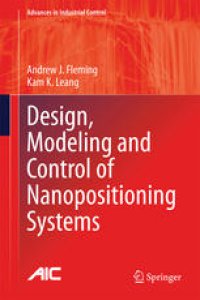
Ebook: Design, Modeling and Control of Nanopositioning Systems
- Tags: Control, Mechatronics, Manufacturing Machines Tools, Industrial and Production Engineering
- Series: Advances in Industrial Control
- Year: 2014
- Publisher: Springer International Publishing
- Edition: 1
- Language: English
- pdf
Covering the complete design cycle of nanopositioning systems, this is the first comprehensive text on the topic. The book first introduces concepts associated with nanopositioning stages and outlines their application in such tasks as scanning probe microscopy, nanofabrication, data storage, cell surgery and precision optics. Piezoelectric transducers, employed ubiquitously in nanopositioning applications are then discussed in detail including practical considerations and constraints on transducer response. The reader is then given an overview of the types of nanopositioner before the text turns to the in-depth coverage of mechanical design including flexures, materials, manufacturing techniques, and electronics. This process is illustrated by the example of a high-speed serial-kinematic nanopositioner. Position sensors are then catalogued and described and the text then focuses on control.
Several forms of control are treated: shunt control, feedback control, force feedback control and feedforward control (including an appreciation of iterative learning control). Performance issues are given importance as are problems limiting that performance such as hysteresis and noise which arise in the treatment of control and are then given chapter-length attention in their own right. The reader also learns about cost functions and other issues involved in command shaping, charge drives and electrical considerations. All concepts are demonstrated experimentally including by direct application to atomic force microscope imaging.
Design, Modeling and Control of Nanopositioning Systems will be of interest to researchers in mechatronics generally and in control applied to atomic force microscopy and other nanopositioning applications. Microscope developers and mechanical designers of nanopositioning devices will find the text essential reading.
Covering the complete design cycle of nanopositioning systems, this is the first comprehensive text on the topic. The book first introduces concepts associated with nanopositioning stages and outlines their application in such tasks as scanning probe microscopy, nanofabrication, data storage, cell surgery and precision optics. Piezoelectric transducers, employed ubiquitously in nanopositioning applications are then discussed in detail including practical considerations and constraints on transducer response. The reader is then given an overview of the types of nanopositioner before the text turns to the in-depth coverage of mechanical design including flexures, materials, manufacturing techniques, and electronics. This process is illustrated by the example of a high-speed serial-kinematic nanopositioner. Position sensors are then catalogued and described and the text then focuses on control.
Several forms of control are treated: shunt control, feedback control, force feedback control and feedforward control (including an appreciation of iterative learning control). Performance issues are given importance as are problems limiting that performance such as hysteresis and noise which arise in the treatment of control and are then given chapter-length attention in their own right. The reader also learns about cost functions and other issues involved in command shaping, charge drives and electrical considerations. All concepts are demonstrated experimentally including by direct application to atomic force microscope imaging.
Design, Modeling and Control of Nanopositioning Systems will be of interest to researchers in mechatronics generally and in control applied to atomic force microscopy and other nanopositioning applications. Microscope developers and mechanical designers of nanopositioning devices will find the text essential reading.
Advances in Industrial Control aims to report and encourage the transfer of technology in control engineering. The rapid development of control technology has an impact on all areas of the control discipline. The series offers an opportunity for researchers to present an extended exposition of new work in all aspects of industrial control.